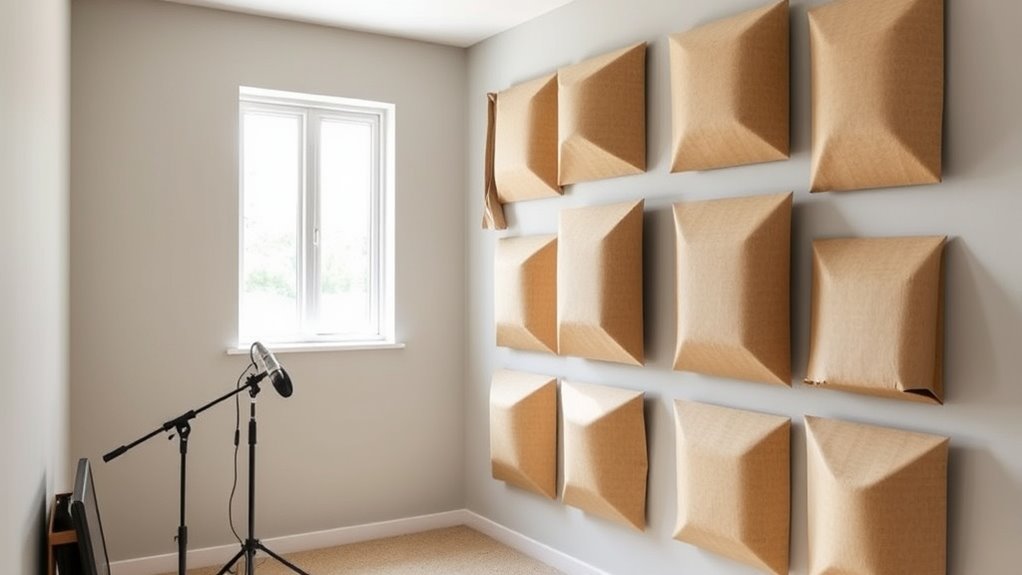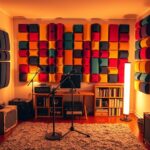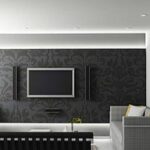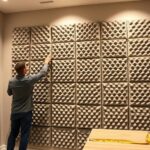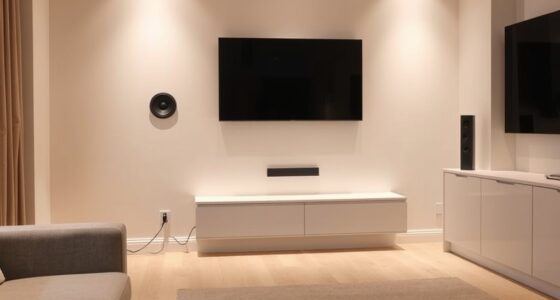To get effective acoustic panels on a budget, focus on DIY solutions using household items like thick curtains, rugs, and soft furniture to absorb sound and reduce echoes. Build simple panels with inexpensive materials like rockwool or recycled textiles, covering them with fabric for a professional look. Place them strategically at reflection points and in corners for the best results. Keep an eye on maintenance, and you’ll find affordable ways to improve your sound environment—more tips are just ahead.
Key Takeaways
- Use DIY panels with affordable materials like fibrous insulation or rockwool covered with fabric for effective sound absorption.
- Place panels at reflection points, corners, and ear level to maximize acoustic treatment efficiency.
- Incorporate household items such as thick curtains, rugs, bookshelves, and wall hangings to enhance soundproofing cost-effectively.
- Seal gaps around doors and windows to prevent sound leaks with inexpensive weatherstripping or draft stoppers.
- Layer and strategically position inexpensive materials to create an effective, budget-friendly acoustic treatment setup.
Understanding Soundproofing and Acoustic Treatments
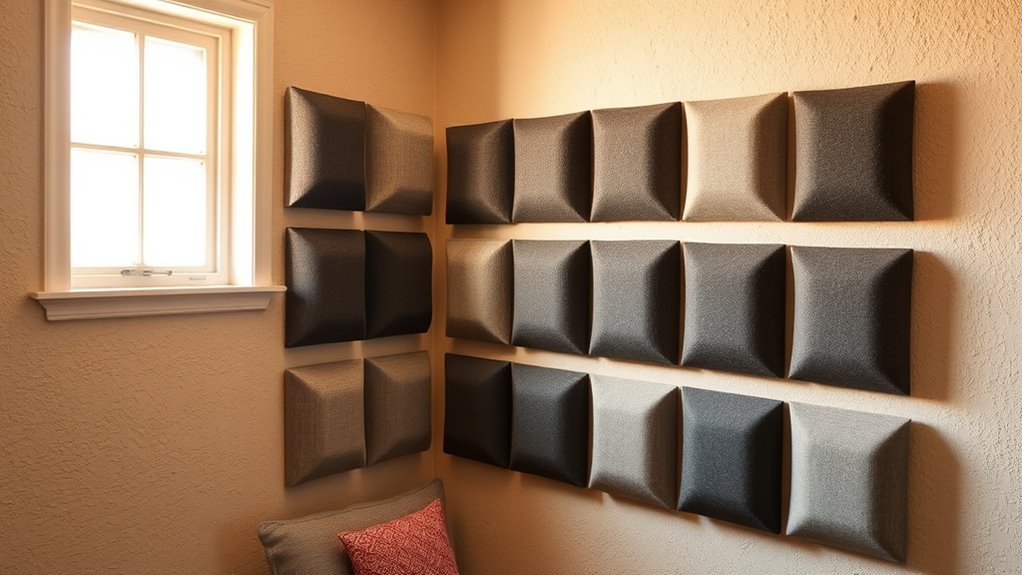
To effectively improve the sound quality in your space, it’s important to understand the difference between soundproofing and acoustic treatments. Many people believe soundproofing myths, thinking it completely blocks all noise, but it mainly reduces sound transmission. Similarly, acoustic treatment myths often suggest that installing panels instantly create perfect sound, which isn’t true. Soundproofing focuses on preventing noise from entering or leaving a room, while acoustic treatments aim to improve internal sound quality by controlling reflections and echoes. Recognizing these distinctions helps you set realistic expectations and choose effective solutions within your budget. Don’t fall for misconceptions—both techniques serve different purposes, and understanding this will guide you toward the best, cost-effective options for your space. Additionally, understanding how sound waves influence brainwave patterns can help you select treatments that promote relaxation and focus. Moreover, selecting affordable acoustic panels that actually work is essential for achieving meaningful sound improvement without overspending.
Choosing Cost-Effective Materials for Acoustic Panels
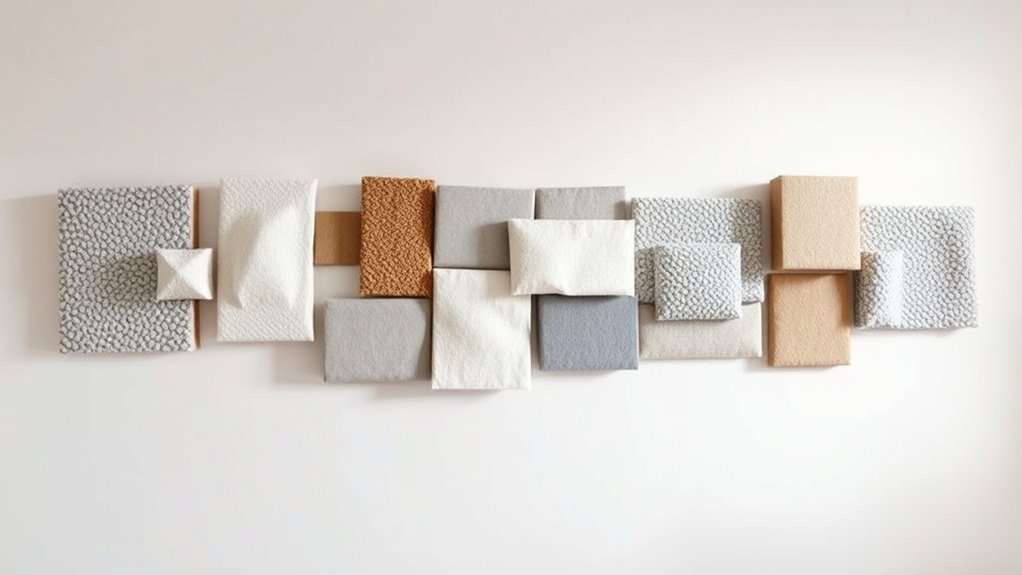
To keep costs down, consider recycled cotton materials that absorb sound effectively without breaking the bank. Egg cartons might seem simple, but they can provide decent sound diffusion in small spaces. You can also explore DIY foam alternatives, which offer a budget-friendly way to improve acoustics without sacrificing quality.
Recycled Cotton Materials
Have you considered recycled cotton materials as a budget-friendly option for acoustic panels? Recycled cotton offers excellent sound absorption and a sustainable choice. It’s affordable and readily available, making it perfect for DIY projects or budget-conscious upgrades. Plus, recycled cotton maintains good material durability, ensuring your panels last over time. When comparing options, keep in mind:
| Material Type | Sound Absorption | Durability |
|---|---|---|
| Recycled Cotton | High | Moderate |
| Fiberglass | Very High | High |
| Foam | Moderate | Moderate |
| Mineral Wool | High | High |
| Egg Cartons | Low | Low |
Recycled cotton balances cost, performance, and eco-friendliness, making it a smart choice for effective, budget-friendly acoustic treatment. It also aligns with sustainable practices and eco-conscious choices, further enhancing its appeal for eco-conscious projects. Additionally, considering the vibrational energy of your space can help optimize sound absorption and overall acoustic quality. Incorporating natural techniques such as strategic placement and proper insulation can further improve the effectiveness of recycled cotton panels. Understanding the material properties can help you select the best approach for your specific acoustic needs.
Egg Cartons Effectiveness
Egg cartons are a popular DIY option for those seeking an inexpensive way to improve sound absorption, especially in small or casual spaces. Many believe that egg cartons can markedly reduce noise, but soundproofing myths often overstate their effectiveness. While they do provide some diffusion and minor sound absorption, they aren’t designed for serious soundproofing or echo control. Egg cartons mainly scatter sound waves, which can slightly improve acoustics in a room, but they won’t block loud noises or reduce echo dramatically. If you’re on a tight budget, they’re a quick fix, but don’t rely solely on them for quality soundproofing. Instead, consider combining egg cartons with other low-cost materials for better results without overspending. Additionally, understanding the limitations of DIY solutions can help set realistic expectations for your acoustic improvements. Recognizing the performance capabilities of different materials can guide you toward more effective soundproofing strategies within your budget. Incorporating proper installation techniques can further enhance their effectiveness and prevent gaps that reduce their acoustic benefits. For optimal results, it’s important to understand the science of sound absorption, which can help you choose the right materials and methods for your space. Exploring the appropriate materials for soundproofing can help you develop a more comprehensive and effective acoustic treatment plan.
DIY Foam Alternatives
While egg cartons offer a basic and inexpensive way to improve room acoustics, they fall short for serious soundproofing needs. For a budget-friendly alternative, consider DIY options like using dense materials that act as soundproof barriers and acoustic insulation. These materials can effectively reduce noise transmission and echo. You can repurpose household items or inexpensive materials to create effective panels. Here’s a quick guide:
| Material | Benefits | Best Use |
|---|---|---|
| Moving blankets | Absorbs sound, inexpensive | Cover walls or windows |
| Old carpets | Dense, good soundproof barrier | Layered on walls or floors |
| Upholstery foam | Lightweight, easy to install | DIY panels, acoustic insulation |
Additionally, understanding soundproofing principles can help you choose the most effective materials for your space. For example, using layered sound absorption techniques can significantly enhance your room’s acoustics while keeping costs low. Incorporating mass loaded vinyl can further improve soundproofing performance without breaking the bank. Using soundproofing materials strategically can maximize noise reduction while maintaining affordability. Employing soundproofing techniques that focus on mass and density can provide better results for a limited budget. These options save money while improving sound quality.
DIY Acoustic Panel Projects That Save Money
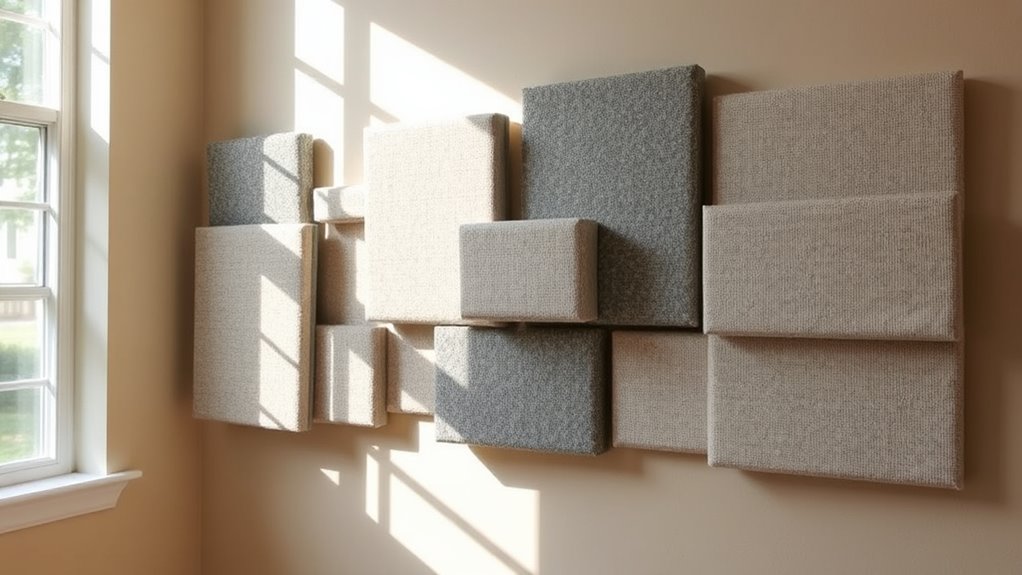
Creating your own acoustic panels is an affordable way to improve sound quality without breaking the bank. You can start with simple materials like soundproof curtains, which block noise and reduce echo. For low-frequency sound issues, a bass trap DIY project is effective and budget-friendly. Building panels using affordable materials like fibrous insulation or rockwool, covered with fabric, offers a cost-efficient solution. You don’t need fancy tools—just basic supplies and some DIY know-how. These projects can be customized to fit your space, whether you’re soundproofing a home studio or creating a cozy listening room. Additionally, understanding sound absorption principles can help you optimize your setup for better acoustics. Incorporating proper placement and acoustic treatment techniques ensures your efforts provide the best results. By making your own acoustic panels, you save money while achieving professional-like sound absorption, making your space more comfortable and acoustically balanced. Exploring regional resources can also help you find additional guidance and supplies to enhance your DIY projects. Utilizing advanced soundproofing techniques can further improve the effectiveness of your acoustic treatments and ensure a quieter, more pleasant environment. Properly selecting soundproofing materials tailored to your needs can make a significant difference in the overall performance of your DIY acoustic panels.
Using Recycled and Upcycled Materials for Sound Absorption
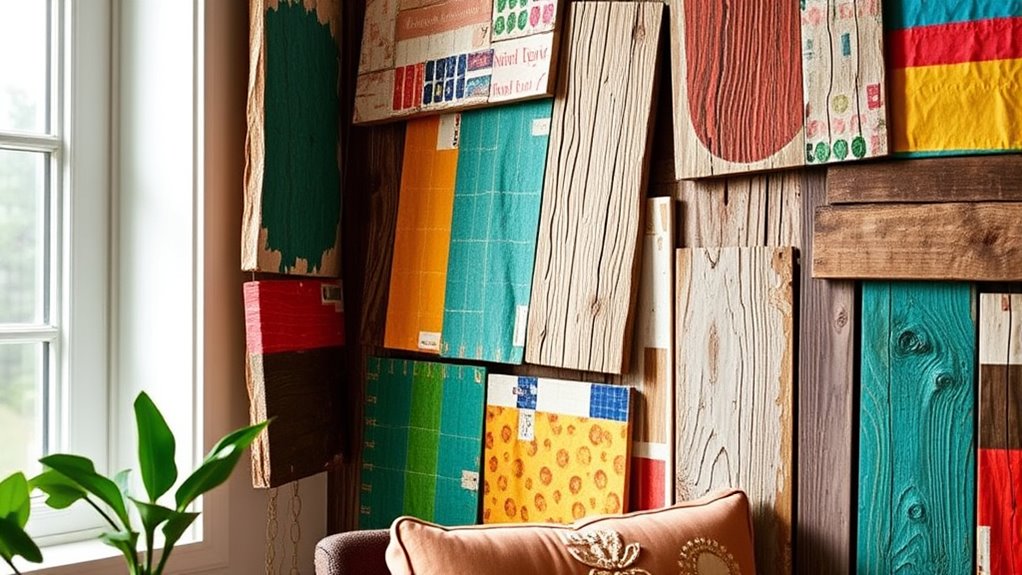
Using recycled and upcycled materials for sound absorption not only helps the environment but also offers an affordable way to improve your space’s acoustics. Upcycled textiles, like old blankets or clothing, can be layered into DIY panels, providing effective sound dampening. Reclaimed wood adds a rustic touch while absorbing sound waves naturally. These materials are budget-friendly and readily available, making them perfect for DIY projects. Consider the table below to explore options:
| Material | Source | Benefits |
|---|---|---|
| Upcycled textiles | Old clothing or bedding | Affordable, effective, eco-friendly |
| Reclaimed wood | Salvaged pallets or furniture | Aesthetic, sound absorption |
| Acoustic foam | Recycled plastic bottles | High performance, customizable |
| Cork panels | Reused wine corks or flooring | Natural sound insulator |
In addition, understanding the sound absorption properties of these materials can help you optimize your acoustic treatment.
Strategically Placing Panels for Maximum Effectiveness
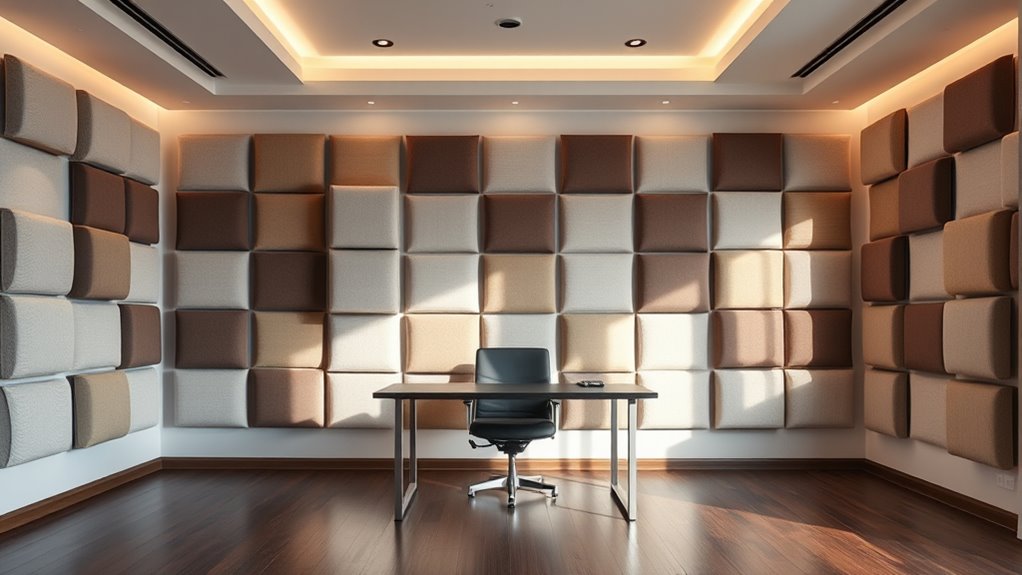
To maximize the effectiveness of your sound absorption efforts, you need to place panels thoughtfully throughout the space. Avoid falling for soundproofing myths that suggest covering every wall is necessary; instead, focus on key areas for acoustic treatment trends. Place panels at primary reflection points, like the wall opposite your speakers or behind your seating, to reduce echo and improve clarity. Don’t forget to target corners where bass tends to accumulate, using bass traps if possible. Be strategic about height—placing panels at ear level makes a noticeable difference. Remember, proper placement boosts sound quality without the need for excessive panels, saving you money. Thoughtful positioning ensures your budget-friendly acoustic panels deliver maximum impact, creating a more pleasant and functional environment.
Creative Ways to Cover Large Areas on a Budget
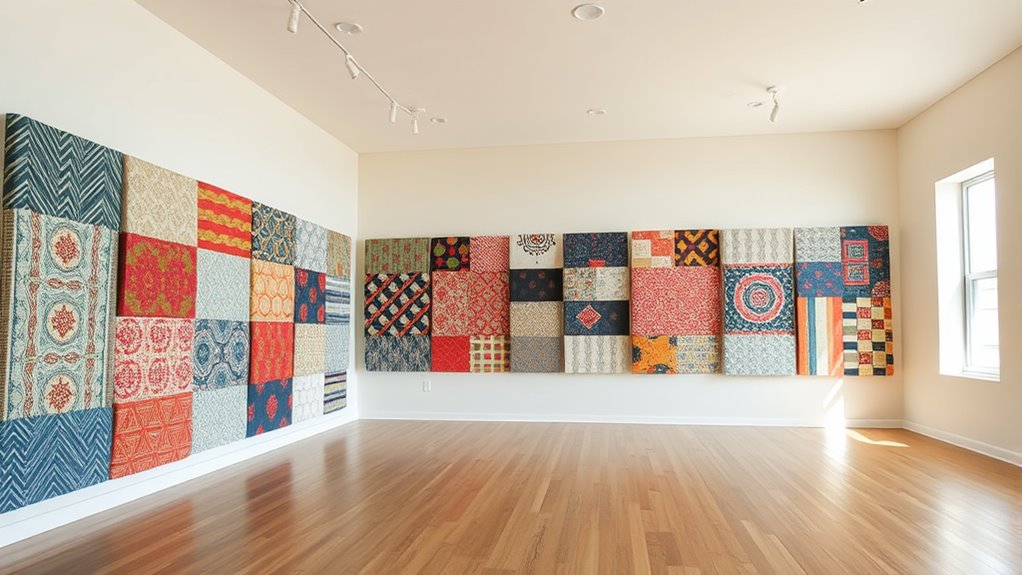
Covering large areas doesn’t have to break the bank. Many soundproofing myths suggest you need expensive panels everywhere, but understanding acoustic design principles shows otherwise. You can create effective coverage by mixing affordable materials like DIY panels, heavy curtains, or rugs. Use large fabric wall hangings or tapestries to absorb sound without high costs. Strategically position these items in reflection points to maximize impact. Think vertically—hang fabric or foam panels from ceilings or walls to cover more space efficiently. Repurposing household items such as bookshelves filled with soft materials or curtains can also help. The key is focusing on critical zones where sound bounces, rather than covering every inch. Creative, budget-friendly solutions combined with soundproofing myths debunked will give you a more acoustic-friendly space without overspending.
Incorporating Household Items as Sound Absorbers

Many household items you already own can double as effective sound absorbers, helping you improve your space without extra expenses. For example, decorative wall art made from soft materials can dampen sound reflections, while strategically placing furniture can block or absorb noise. Rearranging furniture to create more distance between noisy sources and your listening area reduces echo and improves acoustics. Additionally, hanging thick curtains or textiles can absorb sound waves, making the room quieter.
| Household Item | Placement Tip | Effectiveness |
|---|---|---|
| Decorative wall art | Hang at reflection points | Absorbs sound |
| Soft furniture | Position near noise sources | Reduces echo |
| Thick curtains | Cover windows or walls | Dampen sound |
| Rugs or carpets | Cover hard floors | Minimize reverberation |
| Bookshelves | Fill with books, placed against walls | Absorbs sound waves |
Tips for Building Your Own Acoustic Panels at Home
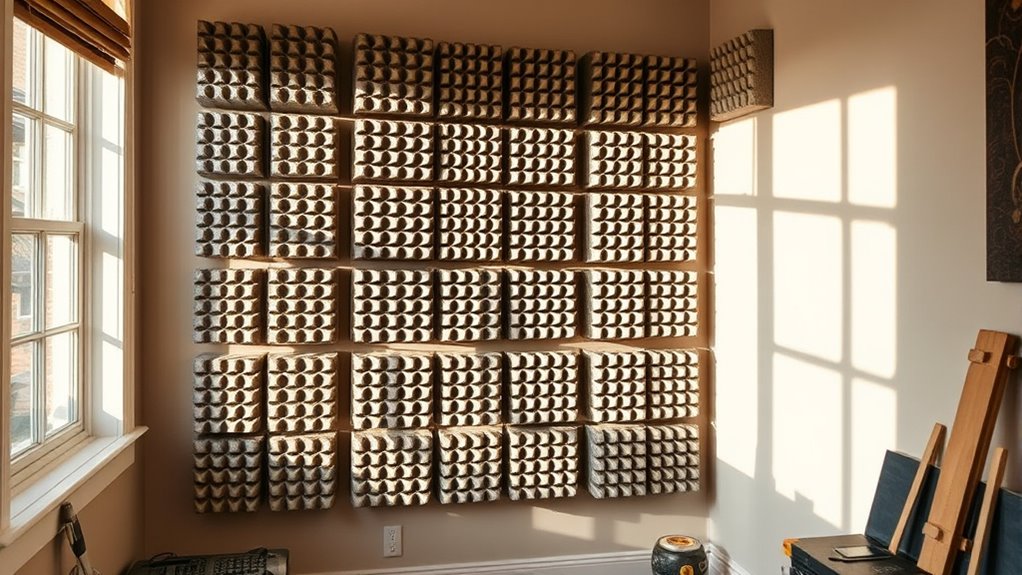
Building your own acoustic panels is a cost-effective way to improve sound quality at home. Focus on choosing affordable materials and simple assembly techniques to keep things easy and budget-friendly. With the right approach, you’ll be able to create effective sound absorbers without breaking the bank.
Choosing Affordable Materials
Choosing affordable materials is essential when building your own acoustic panels without breaking the bank. You want options that balance material durability with aesthetic appeal. Recycled fabrics, foam, and plywood are budget-friendly choices that work well. For durability, opt for dense foam or MDF, which resist warping and damage. For aesthetic options, choose materials that can be painted or covered easily, like fabric-covered panels or decorative wood. Here’s a quick comparison:
| Material | Durability | Aesthetic Options |
|---|---|---|
| Recycled Fabric | Moderate | Easy to customize |
| Foam | Good | Limited, paintable |
| Plywood | Excellent | Paint or stain |
Select materials based on your needs, and you’ll create effective, stylish panels without overspending.
Simple Assembly Techniques
Even if you’re new to DIY projects, assembling your own acoustic panels is straightforward with simple techniques. Start by gathering basic supplies like wooden frames, acoustic fabric, and insulation material. For an easy finish, use staples or a glue gun to secure the fabric to the frame. To enhance soundproofing, consider attaching soundproof curtains behind the panels or placing acoustic ceiling tiles nearby to absorb excess sound. When positioning your panels, hang them at different heights for better sound dispersion. You can also create DIY corner bass traps by stacking panels in corners. Keep it simple—measure carefully, cut accurately, and secure everything tightly. With these techniques, you’ll save money while effectively improving your room’s acoustics without complex tools or skills.
Maintenance and Longevity of Budget-Friendly Acoustic Solutions
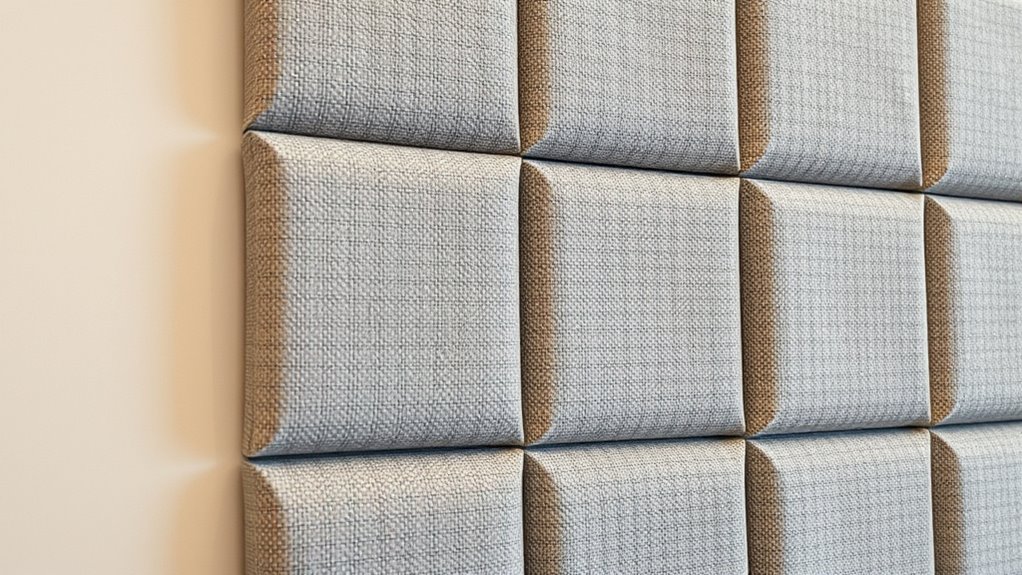
While budget-friendly acoustic panels are an affordable way to improve sound quality, maintaining their effectiveness over time requires regular care. Proper cleaning and routine inspections help preserve their acoustic properties and extend their lifespan. Durability considerations include choosing panels made from sturdy materials and avoiding excessive moisture or direct sunlight, which can weaken the fibers. Regular dusting with a soft cloth or vacuuming with a brush attachment keeps panels free of debris that could diminish sound absorption. Check for signs of damage, such as tears or warping, and repair or replace panels as needed. Here’s a quick overview:
| Maintenance Tip | Reason |
|---|---|
| Dust and vacuum regularly | Keeps panels clean, sustains effectiveness |
| Avoid moisture and direct sunlight | Prevents material degradation |
| Inspect for damage | Ensures longevity and performance |
| Repair or replace damaged panels | Maintains ideal sound absorption |
Enhancing Soundproofing Without Breaking the Bank
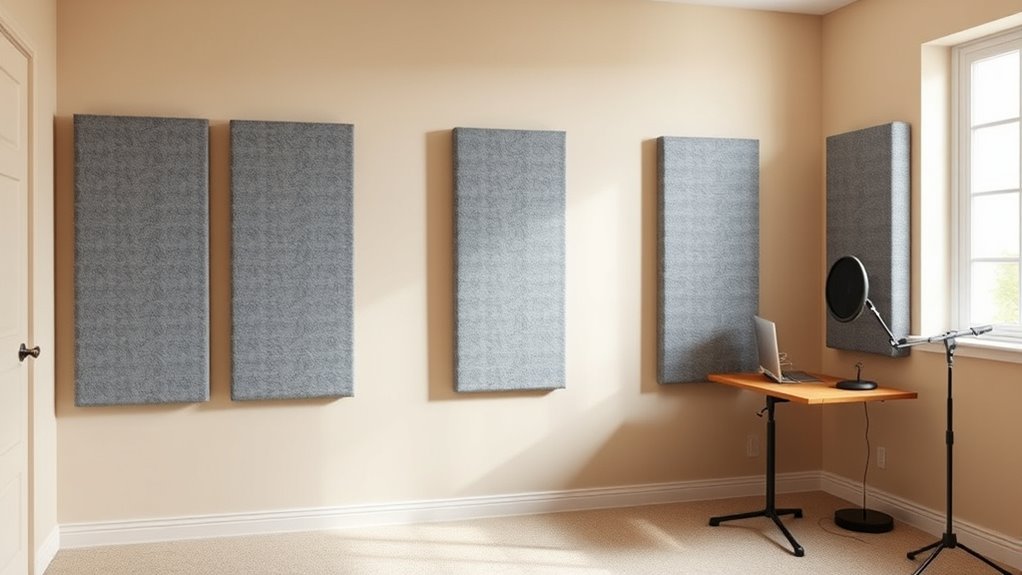
Maintaining your acoustic panels helps preserve their sound-absorbing qualities, but if you’re looking to boost soundproofing without spending a lot, there are simple, cost-effective strategies to contemplate. You can improve room acoustics by adding rugs, curtains, or bookshelves filled with books, which help diffuse sound waves and reduce echoes. For spaces used in music therapy or to enhance architectural acoustics, consider layering panels or placing them strategically to target problem areas. Sealing gaps around doors and windows also prevents sound leaks, increasing privacy and reducing noise transfer. These inexpensive tweaks make a noticeable difference without hefty investments. By combining these methods, you’ll create a quieter environment suited for relaxation, focus, or musical practice, all while sticking to your budget.
Frequently Asked Questions
Can Inexpensive Acoustic Panels Effectively Reduce Noise From Outdoor Sources?
Inexpensive acoustic panels can help with outdoor noise mitigation, but their effectiveness depends on the material durability and design. Cheaper options may absorb some sound, but often lack the durability needed for outdoor conditions, like rain or wind. To maximize noise reduction, choose budget-friendly panels made from weather-resistant materials. Proper placement and sealing also improve performance, making affordable solutions more effective for reducing outdoor noise.
Are There Health Risks Associated With DIY or Recycled Soundproofing Materials?
Ever wondered if DIY or recycled soundproofing materials pose health concerns? It’s a valid question since some recycled materials may contain chemicals or allergens that could irritate your skin or respiratory system. While many recycled options are safe, it’s essential to research and select non-toxic, eco-friendly materials. Always guarantee proper ventilation during installation, and consider testing for potential irritants to protect your health while improving your space.
How Long Do Budget-Friendly Acoustic Panels Typically Last Before Needing Replacement?
Budget-friendly acoustic panels usually last around 5 to 10 years, depending on their panel durability and material longevity. You can expect foam or fabric-covered panels to hold up well if you keep them clean and avoid excessive moisture. Cheaper materials might degrade faster, so periodically inspect them for damage or wear. Proper installation and regular maintenance help extend their lifespan, ensuring you get the most value from your investment.
Do Custom-Sized Panels Improve Sound Absorption Compared to Standard Sizes?
Imagine your space transforms into a sound sanctuary—custom-sized panels can make that happen! Unlike standard sizes, custom sizing dramatically boosts acoustic performance by perfectly fitting your room’s unique dimensions. You’ll notice less echo, clearer conversations, and better overall sound quality. So, if you want serious acoustic results without breaking the bank, investing in custom-sized panels is the game-changer that takes your sound experience from good to extraordinary.
Can Acoustic Panels Be Painted or Decorated to Match Room Aesthetics?
You can definitely paint or decorate acoustic panels to match your room’s aesthetics. Many panels come with painting options or can be customized using decorative techniques like stenciling or fabric wrapping. Just make certain the paint or decor doesn’t block the sound-absorbing surface. This way, you enhance your space’s look without sacrificing acoustic performance, making your panels both functional and stylish.
Conclusion
So there you have it—your wallet’s new best friend in acoustic treatment. Who knew saving money could be so rewarding? With a little creativity and a dash of DIY spirit, you’ll be whisper-quiet without selling a kidney. Just remember, your homemade panels might not win any design awards, but they’ll definitely keep the noise in check. Happy hush-hushing, and may your walls stay silent—cheaply and stylishly!
Hello, I’m Art, and I’m excited to be a part of the 1Home Theatre Projector team. As a writer, I’m here to contribute my knowledge and insights to help you achieve the ultimate home cinema experience. I understand that making decisions in the world of home entertainment can be complex, and I’m here to simplify the process for you.
